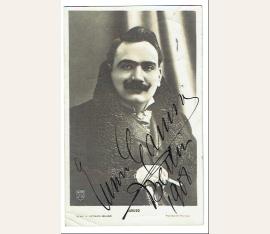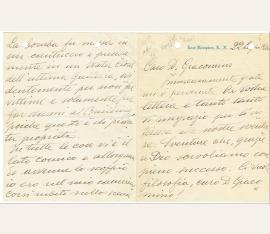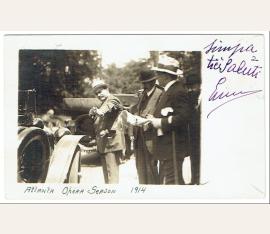Tenor (1873-1921). Rollenphotographie mit vollem Namenszug auf der Bildseite. London. 90:140 mm.
$ 744 / 700 €
(1539)
Enrico Caruso (1873-1921), Italian operatic tenor. Beautiful SP, 3.5 x 5.5 inch, n. p., 1907. A composite postcard of Caruso in costume in „Rigoletto“, in „Marta“ and a smaller portrait of the tenor. With gilt edges.
Tenor (1873-1921). Portrait photograph signed. O. O. u. D. 8vo.
$ 936 / 880 €
(196)
The photograph shows Caruso in full length, in costume for the role of „Vasco di Gama“ from Giacomo Meyerbeer’s opera „L’Africaine“. The photograph is taken by Breitkopf & Härtel in New York. Some creasing, some wear to the margins and mounting traces on the verso.
Tenor (1873-1921). Classic matte-finish 3.25 x 5.25 postcard photo of Caruso in a three-quarter-length pose, signed vertically in supremely bold black ink. In fine condition. O. O. u. D. 8vo.
$ 829 / 780 €
(484)
Aufnahme in ¾-Figur mit Anzug und Mantel. - Die Photographie ist von Mertens, veröffentlicht von Breitkopf & Härtel, New York.
Tenor (1873-1921). Portraitpostkarte mit eigenh. U. auf der Bildseite. London. 8vo.
$ 904 / 850 €
(540)
Italian operatic tenor. Beautiful SP, 3.5 x 5.5 inch, “Enrico Caruso”, London, 1907. A nice half length pose of the tenor. The upper and lower margin slightly trimmed.
Tenor (1873-1921). Portraitpostkarte mit eigenh. U. Wien. 1 S. 8vo.
$ 829 / 780 €
(542)
Italian operatic tenor. Beautiful SP, 3.5 x 5.5 inch, “Enrico Caruso”, Vienna, 1907. A nice three quarter length pose of a relaxed Caruso.
Tenor (1873-1921). Signed postcard photograph. Berlin. 140 : 90 mm.
$ 851 / 800 €
(73643)
Nice head and shoulders postcard of the tenor. - Stamped and addressed on the verso in a different hand.
Italian operatic tenor (1873-1921). 2 letters signed. New York. 4to. 4 pp. 8vo. 6 pp. with two punch holes in upper margins with minor loss to text.
$ 2,658 / 2.500 €
(80579)
„Vorrei, tante volte, ritornare invietro di 25 anni e essere quel piccolo tenore al quale non si questava attenzione!“, Enrico Caruso writes to his friend James O'Connell (“Mio Carissimo D. Giacomino" or "Caro D. Giacomino"), in Italian. „Sometimes I just wish I could turn back 25 years and be that little tenor that nobody paid any attention to!“ The first letter from January 12, 1920 is written on „Hotel Knickerbocker" stationery, Caruso is explaining that he had not decided on the baptism date for Gloria, adding that the Marquis and Marquess Cappelli have offered to be the godparents, apologizing for the miscommunication when he last visited, and asking to convey his devotion to His Eminence.
The second letter on personal stationary (“East Hampton“) from July 22, 1920 is describing how a bomb exploded in the Havana theater where he was to perform, briefly describing his daily routine including the four hours he spends on correspondence, dreaming of again being a young tenor with no responsibilities, hoping that he and his family are well, including His Eminence, and, in a postscript, conveying his wife's greetings and adding that Gloria says hello using her new teeth: "[...] The bomb was placed in a corner of a restroom on the top level, obviously with the idea not to cause victims but rather damage to the building since it is privately owned. To everything there is a comical side and when the explosion happened, I was in my dressing room. I ran out on the stage right away but was bodily rushed out and, dressed as I was, put in a private car, escorted by a warrior on horseback [...] to my house. That was the end of the Havana visit, a visit that gave me a lot to think about because, being Italian and being down there with all the Spanish artists, I had to fight and I won honorably. [...] Time has been passing with playing tennis and bridge, going fishing and taking care of my correspondence for about four hours a day, then studying, reading the papers, taking care of my accounts, receiving visitors, and answering telephone calls from lawyers and detectives. There is no shortage of lawyers and insurance agents giving us their advice, nor of anonymous letters of insults and blackmail. So this is my pastime, aside from being the head of the family . [...] Sometimes I just wish I could turn back 25 years and be that little tenor that nobody paid any attention to! [...]“ Encolosed is the invoice for the first letter and several photographs of other personalities by established Autograph Firm Walter R. Benjamin from April 14, 1947. Enrico Caruso (original name Errico Caruso) was born in Naples, Italy, and became the most admired Italian operatic tenor of the early 20th century and one of the first musicians to document his voice on recordings. He made his La Scala debut with La Bohème (1900). In 1901, after being unfavourably received in his performance in L’elisir d’amore in Naples, he vowed never again to sing in Naples, and he kept his word. World recognition came in the spring of 1902 after he sang in La Bohème at Monte Carlo and in Rigoletto at London’s Covent Garden. He made his American debut in Rigoletto at the opening night of the Metropolitan Opera in New York City on November 23, 1903, and continued to open each season there for the next 17 years, presenting 36 roles in all. His last public appearance—his 607th performance with the Metropolitan Opera—was as Eléazar in La Juive (December 24, 1920). Caruso became the most celebrated and highest paid of his contemporaries worldwide. He made recordings of about 200 operatic excerpts and songs; many of them are still being published. His voice was sensuous, lyrical, and vigorous in dramatic outbursts and became progressively darker in timbre in his later years. Its appealing tenor qualities were unusually rich in lower registers and abounded in warmth, vitality, and smoothness. (Source: Britannica) James P.E. O'Connell (d. 1948) was the nephew of His Eminence William Henry O’Connell, Cardinal and Archbishop of Boston..
Italian operatic tenor (1873-1921). Collection of 13 autogr. postcards, all signed. 3 with loss at upper right affecting only postage stamp. O. O. o. D. 90 : 140 mm. Small area of faint toning at upper right touching portrait, scattered remnants of prior mounting verso. 3 with loss at upper right affecting only postage stamp.
$ 3,721 / 3.500 €
(80582)
Enrico Caruso was travelling a lot throughout his career. This is also documented by this group of 13 postcards, each with an Autograph Note Signed, „Caruso," „Enrico," or „E Caruso," to various recipients, including Enrico and Ada Giachetti, Selma Stieglitz Schubart, Met treasurer Frank Garlich, and others, in Italian, English, French, or German. 5 of them are showing a portrait of Caruso, mostly sending greetings from Saint Petersburg, Saint Paul (MN), Cincinnati, Niagara Falls, New York City, Key West, Florence, or elsewhere. Enrico Caruso became the most admired Italian operatic tenor of the early 20th century and one of the first musicians to document his voice on recordings.
He made his La Scala debut with La Bohème (1900). In 1901, after being unfavourably received in his performance in L’elisir d’amore in Naples, he vowed never again to sing in Naples, and he kept his word. World recognition came in the spring of 1902 after he sang in La Bohème at Monte Carlo and in Rigoletto at London’s Covent Garden. He made his American debut in Rigoletto at the opening night of the Metropolitan Opera in New York City on November 23, 1903, and continued to open each season there for the next 17 years, presenting 36 roles in all. His last public appearance—his 607th performance with the Metropolitan Opera—was as Eléazar in La Juive (December 24, 1920). Caruso became the most celebrated and highest paid of his contemporaries worldwide. He made recordings of about 200 operatic excerpts and songs; many of them are still being published. His voice was sensuous, lyrical, and vigorous in dramatic outbursts and became progressively darker in timbre in his later years. Its appealing tenor qualities were unusually rich in lower registers and abounded in warmth, vitality, and smoothness. (Source: Britannica).
Italian operatic tenor (1873-1921). 4 autograph letters signed. Frankfurt am Main, London, Monte Carlo, Viareggio. 4to or 8vo. 11 pp.
$ 2,126 / 2.000 €
(80583)
A group of 4 Autograph Letters Signed, „Henry il Brutto“ or in full, to various recipients, in Italian or French, announcing a tour in Germany, thanking for condolences [not clear whether for death of his father?], discussing a letter from soprano Marcella Sembrich's husband, and arranging a meeting. Most on folded sheet with terminal page written vertically across internal pages; condition generally good. Enrico Caruso became the most admired Italian operatic tenor of the early 20th century and one of the first musicians to document his voice on recordings.
He made his La Scala debut with La Bohème (1900). In 1901, after being unfavourably received in his performance in L’elisir d’amore in Naples, he vowed never again to sing in Naples, and he kept his word. World recognition came in the spring of 1902 after he sang in La Bohème at Monte Carlo and in Rigoletto at London’s Covent Garden. He made his American debut in Rigoletto at the opening night of the Metropolitan Opera in New York City on November 23, 1903, and continued to open each season there for the next 17 years, presenting 36 roles in all. His last public appearance — his 607th performance with the Metropolitan Opera — was as Eléazar in La Juive (December 24, 1920). Caruso became the most celebrated and highest paid of his contemporaries worldwide. He made recordings of about 200 operatic excerpts and songs; many of them are still being published. His voice was sensuous, lyrical, and vigorous in dramatic outbursts and became progressively darker in timbre in his later years. Its appealing tenor qualities were unusually rich in lower registers and abounded in warmth, vitality, and smoothness. (Source: Britannica).
Italian operatic tenor (1873-1921). Small 8vo. 3 pp. Minor loss to two corners, pinholes in upper margin. On „Hôtel de Paris" stationery. With the original envelope, with cancelled 25-centime postage stamp. Monte Carlo. Small 8vo. 3 pp. Minor loss to two corners, pinholes in upper margin. On „Hôtel de Paris" stationery. With the original envelope, with cancelled 25-centime postage stamp.
$ 1,595 / 1.500 €
(80584)
„[...] I have already given two performances of Aida with spectacular success. Life is very busy, despite all the wounded soldiers in the streets. The impresario from the Colon in Buenos Aires who is negotiating with me came by boat from Napoli to Genoa, and within two days I signed a contract for 10 performances at 35,000 francs each. [...]." The autograph letter signed, „Caruso," is addressed to cellist Enrico M. Scognamillo, in Italian, thanking for the clothing sent to Caruso's son Enrico (“Mimmi").
The letter is written on a folded sheet with third page written vertically across interior pages with minor loss to two corners, pinholes in upper margin. With the original envelope, with cancelled 25-centime postage stamp. In the letter Caruso is reporting two successful performances in Aida, noting the presence of wounded soldiers in the streets, stating that he has been contracted to perform in Buenos Aires, and giving travel dates. Caruso became the most celebrated and highest paid of his contemporaries worldwide. He made recordings of about 200 operatic excerpts and songs; many of them are still being published. His voice was sensuous, lyrical, and vigorous in dramatic outbursts and became progressively darker in timbre in his later years. Its appealing tenor qualities were unusually rich in lower registers and abounded in warmth, vitality, and smoothness. Enrico Scognamillo was a close friend of the tenor. In December 1923 New York newspapers are reporting on a legal battle, Scognamillo’s widow fought a legal battle with against Caruso’s manager, for a third of the profits received by Mr. Coppicus from the Caruso engagements..
Italian operatic tenor (1873-1921). Autograph Letter Signed, "Caruso," to his private secretary Bruno Zirato ("Dear Zirato"), in Italian. East Hampton. Small 8vo. 3 pp. folds.
$ 1,595 / 1.500 €
(80586)
This letter was written one year before Caruso’s death, signed, „Caruso," to his private secretary Bruno Zirato (“Dear Zirato"), in Italian, sending a check for expenses [not present], declining to read articles because he is engaged in other things at the moment, complaining of pain, reporting that he has read about the success at the stadium: "[...]. Articles -- I am not in such a hurry since I have only to do Mexico and begin the Metropolitan [...] [H]ere it is rather cool, and I suffer terribly with pain all over.
I have read about the immense success at the stadium and so many congratulate me about it. [...]“ Bruno Zirato (1884-1972) was Enrico Caruso's private secretary and managing director of the New York Philharmonic from 1956 to 1959. Only a few months after this letter, Caruso’s health began a distinct downward spiral in late 1920 after he returned from a lengthy North American concert tour. During a performance of L'elisir d'amore by Donizetti at the Brooklyn Academy of Music on December 11, 1920, he suffered a throat haemorrhage and the performance was canceled at the end of Act 1. Following this incident, a clearly unwell Caruso gave only three more performances at the Met, the final one being as Eléazar in Halévy's La Juive, on 24 December 1920. By Christmas Day, the pain in his side was so excruciating that he was screaming. Dorothy summoned the hotel physician, who gave Caruso some morphine and codeine and called in another doctor, Evan M. Evans. Evans brought in three other doctors and Caruso finally received a correct diagnosis: purulent pleurisy and empyema. Caruso was the most celebrated and highest paid of his contemporaries worldwide. He made recordings of about 200 operatic excerpts and songs; many of them are still being published. His voice was sensuous, lyrical, and vigorous in dramatic outbursts and became progressively darker in timbre in his later years. Its appealing tenor qualities were unusually rich in lower registers and abounded in warmth, vitality, and smoothness..
Tenor (1873-1921). Portraitphotographie mit eigenh. Unterschrift auf der Bildseite. Wien. 8vo (140 : 90 mm). 1 p.
$ 691 / 650 €
(86763)
Bekanntes Kniestück des Tenors. Leicht fleckig. Auf der Rückseite von fremder Hand adressiert und postgelaufen. Aus der Sammlung des Wiener Anwalts Max Bettelheim (1912-1971). Von dessen Nachfahren übernommen.
Tenor (1873-1921). Eigenhändige Selbstkarikatur mit Unterschrift und Datierung. ohne Ort. 8vo (119 : 186 mm). 1 p.
$ 2,658 / 2.500 €
(86974)
Hübsche Selbstkarikatur mit feiner Feder des äußerst talentierten Zeichners. In der unteren Ecke voll signiert und datiert. Hübsches Sammelstück.
Tenor (1873-1921). Ms. Brief mit eigenh. Unterschrift. New York. 8vo. 1 p. Hotelbriefpapier „Hotel Knickerbocker“, New York“.
$ 425 / 400 €
(92842)
An Herrn Ara: „Ho ricevuto la sua lettera e la ringrazio assai della sua squisita esibizione e gentilezza a mio riguardo. Le auguro buon viaggio e in Italia il piu’ gran possibile successo, ed al piacere di riverderla ancora in America la stagione ventura, mi creda con sensi di osservanza […]“
Tenor (1873-1921). Autograph picture postcard, unsigned. St. Petersburg. 02.03.1900. 1 S. Qu.-8vo. Mit eh. Adresse.
$ 266 / 250 €
(33211/BN28116)
To Enrico Giachetti in Milano: "[...] Oggi 2 non ò recevuto niente perche? Avvisami quando hai finito [...] Siamo sempre da capo con la storia dei giornali, perche non me la spedisce giorno per giorno [...]". - Traces of mounting on reverse.















